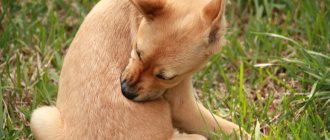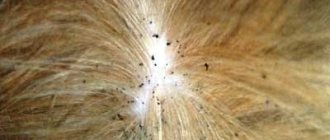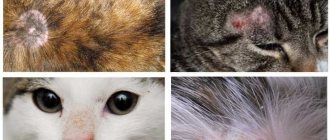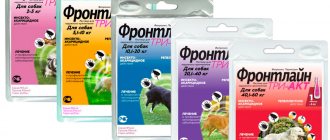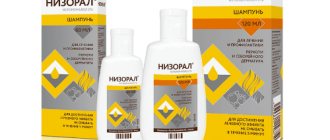If the dog itches a lot, most owners assume that the culprit is fleas - small blood-sucking brown or black insects that, in addition to itching, bring their pets a lot of other inconveniences in the form of anemia, skin inflammation, restless sleep and exhaustion.
But the reason for a pet’s constant scratching is not always due to the presence of fleas on its body. Itching can also be caused by other bloodsuckers, and even some diseases of the internal organs. In this article we will try to figure out why a dog itches if it doesn’t have fleas.
, what are the reasons for such a misfortune.
Possible reasons
Most often, itchy dermatitis is caused by ectoparasites. But what to do when your dog itches a lot but doesn’t have fleas? The owner takes care of the pet, regularly treats the skin with insecticidal sprays or drops, but pruritus bothers the dog. Insect attacks most often occur in the summer, but the animal itches even in cold weather, when there are no fleas. The following factors cause itching are distinguished:
- Stress.
- Injuries.
- Contact with irritants.
- Exposure to heat or cold.
- Parasites.
- Allergy.
- Infection.
In all cases, when eliminating itchy dermatitis, in addition to specific medications, antibacterial agents, as well as antimycotics, will be required.
Continues after processing
If you have just treated your puppy for fleas or put an anti-parasitic collar on him, it is normal for the itching to increase.
Insects begin to run over the animal’s body in search of salvation, thereby causing it even more discomfort. This is a temporary phenomenon that goes away with the destruction of pests (8-12 hours after treatment).
But sometimes, the cause of double itching is an allergy to one of the components of the anti-flea drug or its contact with open wounds (bites).
Stress
Dogs, especially puppies, are impressionable creatures. After purchase, the baby is brought to a new home. Everything is unusual: the food, the decor, the people around you. The pet experiences a feeling of itchy skin. The puppy is itching, but there are no fleas.
Similar symptoms are observed in adults during or after an expert exhibition. Some dogs do not cope well with travel and transportation. An inadequate reaction to changes in living conditions also occurs in adult dogs. Transferring from a kennel to an apartment or vice versa causes a feeling of confusion. There are individual and breed predispositions to stress.
The irritated condition in most cases goes away without treatment, the itching stops spontaneously. However, the dog owner needs to watch the pet. If you notice that your dog reacts violently to changes in the environment, Stop Stress or Kot Bayun medications can help. They should be taken 5 days before the expected event and for the same time after.
Check out our review of sedatives for dogs.
What to do if your dog itches all the time
If your pet scratches itself once or twice a day, then there is no reason to worry. And when the itching literally exhausts the animal? If your dog has lost peace and sleep, constantly scratching and licking his body, it’s time to take action. To relieve skin inflammation, animals are given corticosteroids (Cortisone, Dexamethasone, etc.), and antihistamines (Tavegil, Suprastin, etc.) to eliminate itching. Wounds on the body are treated with antiseptic drugs (Levomekol, Zinc ointment, etc.). If you are sure that the scratch is caused by the presence of parasites, insectoacaricidal agents are used (Advocate, BARS Forte, etc.).
But it is better not to carry out therapeutic measures on your own, since only a doctor can prescribe the correct treatment after examining the tailed patient and conducting the necessary studies (skin scrapings, culture, biopsy, biochemical blood test, etc.). Unfortunately, it will not be possible to determine “by eye” what the dog is sick with. The same sarcoptic mange can easily be confused with pyoderma or dermatitis. In addition, as we found out, itching of the skin, although atypical, is still a sign of some diseases of the endocrine, digestive and urinary systems, and here antihistamines, antiseptics and hormones alone cannot be used.
Injuries and wounds
The skin around the affected area becomes hyperemic, swollen, and itchy. Ulcers form. The dog scratches the sore spot, the pathological surface expands. If your dog has had surgery, the healing stitch may also be itchy. Help consists in the destruction of microflora, the waste products of which cause pruritis.
I recommend Terramycin.
Use an antiseptic aerosol. If the itchy areas are covered with hair, cut it off and treat the wound surface with a spray as needed. Terramycin spray, Alamicin, and other antiseptics are in demand.
Hyperfunction of the sebaceous glands
Greasy tail in dogs
Some dogs exhibit a pathology called “greasy tail.” This pathology is more common in cats, but can also occur in dogs. Hyperfunction of the sebaceous glands, located like a rosary on the upper surface of the tail and around its base, leads to sticking of the hair, the formation of black spots on the skin, and the appearance of oily seborrhea. Itching causes the dog to chew its tail, “ride” on its butt, and causes severe discomfort. A dog's licking of affected areas can cause alopecia or serious tail injuries.
Treatment consists of treating the wool with special shampoos to regulate the function of the sebaceous glands. Until the cause of hyperfunction is determined, this is the only method.
Contact with irritants
Indoor dogs are regularly treated with insecticides, because ectoparasites plague not only pets. The animal does not have fleas, but it is constantly itching. It is necessary to analyze what physical or chemical irritants can cause itching.
In winter, the decorative dog lives close to heating radiators. The skin dries out and cracks. Skin defects are inseminated by the microflora that constantly lives on the dog, and dermatitis develops. They use aerosol antiseptics and move the dog’s den away from the battery.
Excessive care for your pet leads to the opposite result. Bathing with a low-quality detergent dries out the skin and causes pruritis. If you frequently bathe your pet with a good shampoo, he will also develop itchy dermatitis. The protective fat layer is washed off from the surface of the skin, as well as hairs. The hairs break, the skin dries out. Dogs do not need to be bathed unless they are very dirty.
Most situations do not require drug treatment. Recovery occurs after the causes are eliminated.
Ear mite
If your puppy is constantly itching and acting restless, as well as whining and shaking his head, then he may have picked up ear mites. Ear scabies can occur due to infection with a special type of mite, Otodectes cynotis. When they get into the ears, they feed on the dog’s blood. This disease is most often seen in cats, but dogs can also contract it from another infected animal.
Ear mites occur in adult dogs, but small breed dogs or puppies are especially susceptible to them because they have weak immune systems. Symptoms accompanying this disease:
- Dark purulent discharge from the ear canals.
- Itching appears.
- The animal tears the skin around the ears with its claws, causing wounds and bald spots.
- The dog is acting restless and shaking its head.
If you do not start treating the animal in time, then this sore can lead to complete loss of hearing, and in some cases, to the death of the pet.
Exposure to heat or cold
The dog licks the burned or frostbitten surface. Acral dermatitis develops. Decomposition products of dying tissues cause intoxication. are not enough for this treatment . Invite a veterinarian and administer antibiotic therapy under his supervision. The specialist decides which drugs to use and how to administer them - orally, intramuscularly or subcutaneously.
In the hot sun, the skin dries out and bursts. The microflora, which is ubiquitous, is activated. The slightest abrasion or mosquito bite opens the gates for infection, pustules form, and itchy pyoderma develops.
The affected surface is treated with an antiseptic spray. For prevention, cooling scarves, blankets or mats are used. Do not put wet cloth on your dog. Slowly evaporating moisture overcools the pet and causes pneumonia. If the air conditioner is on, the dog is placed in another room and the door is closed to avoid drafts, which can also cause pneumonia.
Dogs can only be bathed in clean waters. Otherwise, the microflora rapidly developing in warm water will begin to develop on the dog’s skin, causing itching.
Cooling gussets are provided for hot weather.
Ectoparasites
The cause of itching in a dog may be infection with ectoparasites. In this case, clinical manifestations can be both obvious and hidden, appearing only some time after the parasites enter the skin. The following types of diseases caused by external parasitic organisms can be distinguished:
- cheyletiellosis;
- thrombiculidosis;
- demodicosis;
- ixodidosis;
- lice, lice;
- ear scabies.
Cheyletiellosis or wandering dandruff is less common than other diseases of parasitic etiology. Caused by Cheyletella mites. When infected, the animal experiences itching in the neck and along the back. In these places, severe redness occurs, the skin peels off, pustules and papules form, which become covered with black crusts due to scratching. Due to a violation of the integrity of the skin, purulent and pathogenic fungal microflora enter, eczema and various dermatitis develop. If left untreated, the disease can be fatal.
Demodectic mange is caused by mites; with proper treatment, the disease goes away within 6-8 weeks. But, if it becomes a generalized form, it poses a serious threat to life. Diagnosis includes microsporia from deep skin scrapings. Hair microsporia may also be informative. Examination and analysis of scrapings is carried out monthly; if there is no response to treatment, it is necessary to change therapy.
Otodectosis or ear scabies can also be the reason why your dog is constantly itching. The disease is caused by ticks that feed on epithelial debris and tissue fluids. Scabs in the ears and other parts of the animal's body can be a sign of the presence of parasites. Systemic and local drugs are used for treatment.
Thromboculidosis is a sporadic disease caused by red mite larvae. Parasites are located on the dog's body in close groups, mainly on the head, paws, around the tail, and on the stomach. In these places, the skin swells, turns red, papules and vesicles appear. The animal experiences severe itching. If a dog's back itches near its tail, it may start chasing it for no reason. Anxiety and sometimes aggression appear.
Ixodidosis or tick-borne toxicosis is caused by ixodid ticks. The disease occurs in both dogs and cats. Parasites attach to the delicate skin in the ears, neck, abdomen, and inner thighs. It is easy to detect ticks - by parting the fur, you can see them attached to the skin.
Lice eaters are sedentary parasites that are difficult to notice in fur. They are small in size and pale yellow in color; they feed on particles of the epidermis and secretions from scratches. The female parasite lays eggs and attaches them to the dog's skin, the larvae very quickly hatch and turn into adults, expanding the affected area. You can suspect the presence of lice eaters if bald areas appear on the animal’s body, the fur becomes dull, disheveled in places, and small light grains are found that can be confused with dandruff. And, of course, the main symptom is severe itching. Lice eaters provoke allergic dermatitis, the skin at the site of scratching becomes covered with scabs, local immunity decreases, and the dog is susceptible to bacterial infections. Treatment must be started urgently. Lice eaters can not only lead to complete baldness of your pet. They can become a source of infection with the helminth – cucumber tapeworm. Therefore, therapy includes the use of drugs against external and internal parasites.
Parasites
Pruritis is a symptom of a dog being infected with subcutaneous mites and nematodes . Clinical signs appear primarily in puppies and older dogs with weakened immune systems. Short-haired dogs get sick more often than long-haired dogs. Animals kept in unsatisfactory conditions and receiving unbalanced feeding are predisposed to illness. The peak of the disease is observed in the warm half of the year.
Demodexes are permanent inhabitants of dog skin. They inhabit sebaceous glands, hair follicles, and eat their contents. In animals with a strained immune system, clinical signs of the disease do not occur. Scabies is accompanied by dermatitis. The scratched surface becomes infected with microbes.
Treatment is developing in the following areas:
- Destruction of parasites . The wool is cut. Use external acaricidal preparations based on amitraz at weekly intervals. Pesticides eliminate sexually mature individuals. The eggs hatch into larvae that must be destroyed before they become sexually mature. The course of treatment consists of 3-5 treatments. An alternative is acaricidal tablets Milbemycin or Sayfli. They are safe and easy to use. But the course of treatment continues for months.
- Elimination of symptoms of dermatitis . Bacteria and fungi develop on damaged skin, which are ubiquitous. Therefore, antibiotics are used in combination with antimycotics.
- Immune stimulation . The injection agents used are Gamavit, Katozal, Phosprenil, Maxidin.
Ticks that cause sarcoptic mange, notoedrosis and otodectosis get on the skin of dogs with weakened immune systems through contact with cats or stray relatives. The principle of treatment is the same as for demodicosis. Notoedrosis is mild and often ends with spontaneous recovery. Otodectosis is characterized by damage only to the inner side of the ear. Experts consider Surolan, which is instilled into both ear canals, to be an effective drug for treating ear mites.
High infestation with nematodes is characterized by skin rashes, disheveled fur, and baldness. Parasitic worms consume all the vitamins supplied with food, block their absorption from the intestines, and release metabolic waste into the blood.
Treatment consists of deworming. Use Dirofen, Drontal or Kanikvantel. Dying parasites secrete poisons, so detoxicants are used.
Parasitic diseases and associated financial expenses for treatment can be avoided in the following ways:
- feed and maintain the dog in accordance with veterinary and sanitary requirements;
- carry out quarterly deworming;
- limit contact with stray animals.
Methods for treating dogs for itching without fleas
Methods for treating itching in the absence of parasites:
- with increased sensitivity. It is necessary to normalize the dog's nutrition. The modified diet should contain the optimal amount of various vitamins and minerals that your pet needs. It is also better to exclude your pet from eating meat for a while;
- with weeping lichen. You need to use special drugs, for example, Mercurius. Such products must be used according to instructions. As secondary measures, it is necessary to apply bandages with ointments and carry out water procedures. It’s better for your pet to forget about meat and potato dishes for a while;
- for dry lichen. Changes in skin color, rashes, peeling and itching are symptoms of lichen. In this case, it is necessary to isolate the pet from other animals and begin a medicinal course of treatment. You need to bathe your dog as often as possible with a mild, soothing soap, treating wounds with linseed oil. Add no more than 10 drops of Dulcamara 3 or Phosphorus 3 to food;
- for scabies and scabs. The diseases are too contagious, and because of this, the pet must be isolated from other animals. You should carry out water procedures with special creolin soap and linseed oils, change your pet’s diet;
- if you have a food allergy. It is necessary to ensure that the pet does not consume an allergenic product, which can be detected with the help of a veterinarian.
Most often, special means are used to treat itching:
- antihistamines. They can relieve your pet of itching only in 50% of cases. The only side effect may be drowsiness, but otherwise these drugs are safe. Typically, antihistamines are used in the absence of any serious diseases. May also be used for other allergic symptoms;
- fatty, natural acids. They are an auxiliary remedy that is used for minor illnesses;
- anti-inflammatory lotions and ointments. In some cases, ordinary cool water may have a similar effect;
- colloidal oatmeal. Has a strong anti-inflammatory effect and removes toxins from the body;
- sulfur-based solutions. They are versatile and effective. Such products dissolve proteins on the skin, but the downside is an unpleasant odor and a change in the color of the dog’s coat;
- anti-parasite shampoos. Such shampoos are very versatile, have a calming effect and are usually applied for a while and then washed off;
- solutions or sprays containing gum lac. There is no need to wash off such products, as they dry themselves after spraying. It is better to use together with a sulfur solution;
- corticosteroids. Such substances are used for particularly severe forms of disease. They have properties that negatively affect the body.
In addition, folk remedies can be used. You can relieve itching at home using cold herbal infusions: calendula, echinacea, comfrey. Aloe vera juice can also come to the rescue.
You can relieve your dog of itching during shedding using a special comb.
Dog owners should never forget about the help of veterinarians, because only they can give truly accurate and practical advice. Home treatment can only harm your four-legged friend. No one can make diagnoses in absentia, so if your pet has itching, feel free to take him to the veterinary clinic.
Allergy
Immune bodies protect the body from foreign proteins. Protective cells compare the structures of proteins received from outside with their own. If they do not match, a violent inflammatory reaction destroys the alien. When the foreigner recognition mechanism fails, an allergic response develops. Cells mistake harmless compounds for virulent ones.
A dog with a damaged immune system experiences reactions characterized by dermatitis, swelling, and conjunctivitis. If your pet itches frequently, but no fleas are found on its skin, an allergy is suspected.
An inadequate response to stimuli occurs for the following reasons:
- side effects of medications;
- response to external stimuli (atopic dermatitis);
- feed allergy.
Side effects of medications
Skin itching is the least evil that occurs as a side effect of medications. Typically, a reaction occurs to the use of medicinal serums and antibiotics. If your dog is itching, you need to find out what medications he is taking and stop them . To relieve allergy symptoms, antihistamines are used - Suprastin; Tavegil; Diphenhydramine.
Prevention of disease is the responsibility of the veterinarian prescribing treatment. The use of drugs with side effects should be avoided, and if this is not possible, oral therapeutic forms should be preferred to parenteral ones.
Atopic dermatitis
Difficult to diagnose. However, attentive dog breeders note that the acacia tree has bloomed and their beloved dog is itching. The owner used new perfume, a friend came and lit a cigarette - the dog started having problems.
Atopic dermatitis
An allergic response can occur to household chemicals, plant protection products, the smell of gasoline, indoor plants, cat hair, and street dust. Antihistamines provide only momentary relief. You can get rid of the disease if you give up your own habits and interrupt your pet’s contact with the allergen. It’s painstaking work, but the pet’s health is more important.
Feed allergy
I remember an interesting incident. A big man with a Caucasian Shepherd puppy in his arms visited the Kennel Club. The baby was 4 months old, weighed 25 kilograms. His whole face was covered in acne. The owner worked as a cook in a restaurant for sailors, fed the pet table scraps and wondered why the puppy had dermatitis. They explained to him that the cause of the illness was spices.
If you give your dog human food, be careful. Adherents of natural food need to be prepared for the fact that the pet will react to any component of the food. It is difficult to identify the irritant.
The use of ready-made feed mixtures can also have a negative impact. Therefore, change feed gradually. On the first day, mix 1/4 of the new food with 3/4 of the old. The next day, the portion of replacement food is increased. Most often, an allergic response occurs to chicken meat. Therefore, choose a recipe with duck, fish or lamb.
If such a change in diet does not help, use Hill's z/d or Royal Canin Anallergenic therapeutic food for dogs with food allergies and intolerance to food components.
Diagnostics
To figure out what exactly caused the dog's itchy skin, you need to consult a veterinarian. To make a diagnosis, you may need a whole range of diagnostic measures:
- Scraping
It is taken from the affected areas of the skin. Laboratory analysis of the material will identify parasites or microbes.
- Analysis of skin secretions
If discharge is present, it is subjected to a separate analysis to clarify the diagnosis.
- Stool examination
First of all, determines the presence of worms in a dog
- Blood analysis
First of all, it helps to identify the presence of allergies and the specific allergens that cause them.
Infection
Infectious diseases are rarely the main cause of pruritic dermatitis. Conditionally pathogenic fungi and bacteria always live on the skin of dogs, but are activated only when the immune defense fails. The main reasons are unsanitary conditions and unbalanced feeding.
Intradermal mites gnaw passages and destroy capillaries. The ichor emerges - an ideal breeding ground for microbes. Uncontrolled use of antibiotics destroys bacteria - the main competitors of microscopic fungi. We discussed above how to resist bacterial infections. But what to do if fungi become active?
Most often, infectious diseases of mycotic etiology are called ringworm. Accurate diagnosis is carried out in the clinic. If the pathological focus occupies a limited area, ointments are used - Yam, Clotrimazole or Mycozon. Aerosols - Exoderil or Fungin - are considered more convenient means.
In case of large-scale lesions, the dog is bathed in a solution of Fucoricin or Imaverol. In severe situations, take Griseofulvin tablets.
On topic: The dog has red spots on its stomach.
Prevention
Prevention is better than cure in moral and material terms. I will tell you what needs to be done to minimize the risk of developing the disease. Fulfill the following conditions:
- Ensure that the living conditions comply with sanitary standards. The optimal air temperature is 15-16°C, humidity is from 40 to 70%.
- Natural food is better than prepared food, provided that the diet is balanced in nutrients and energy. In practice this is difficult to achieve. Recipes from the Internet are not suitable because the actual nutritional content of the ingredients may differ from those given in the recipe. Therefore, use factory-made food . If your dog has a food allergy, appropriate nutrition is always an option.
- quarterly deworming .
- Avoid bathing your pet with detergents.
- In hot weather, use cooling mats, scarves, or blankets.
- In the presence of a dog, do not smoke, do not use perfumes, and prevent your pet from coming into contact with household chemicals.
